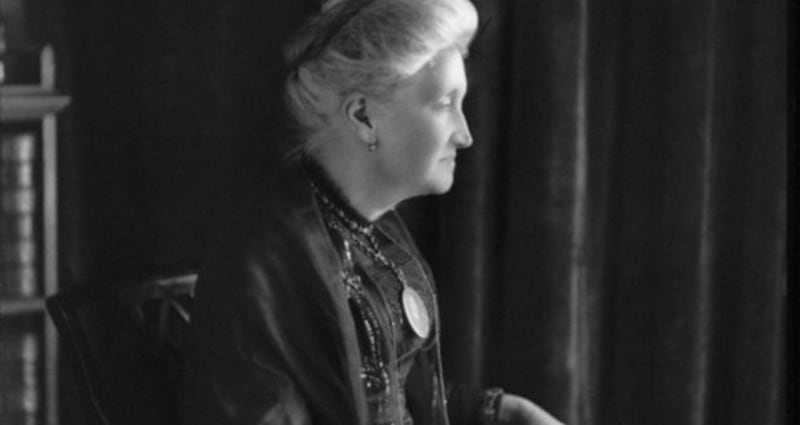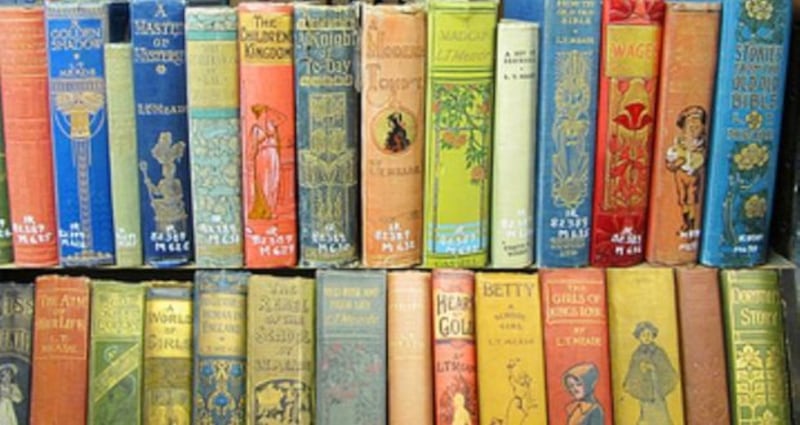Four Irish schoolgirls (and a wee English fella) exploded onto our screens and stole our hearts earlier this year in the form of Derry Girls, Lisa McGee’s joyfully funny series set in Derry in the early ’90s. The girls are boisterous, unruly and completely hilarious. They are naïve and wise, sweet and sweary. In each episode, the girls get involved in some kind of outrageous scrape from accidentally setting the chip shop on fire to convincing a doubtful priest that a local statue of the Virgin Mary is crying (the tears are actually due to a dog urinating directly above the statue) and the series concludes in particularly effective and poignant ways in the final episode.
Derry Girls is almost unique in its realistic and joyful portrayals of Irish girls who are loud, unruly and take up space – in their world, on our screens and in our hearts. For me, the presence of these bold girls on my TV screen struck a chord, not least because my research focuses on some other unruly Irish school girls, separated from Erin, Michelle, Orla and Clare by a century.
I am writing a book about literature for and about Irish girls at the end of the 19th and beginning of the 20th centuries, which I’m finding is a particularly potent moment for the Irish adolescent girl in literature. What’s interesting for me is that the unruly disruptiveness of the Derry girls have antecedents in much earlier fiction, such as that by LT Meade, Rosa Mulholland and Katharine Tynan, all of which is reflected in Trinity College Dublin’s current exhibition, Story Spinners: Irish Women and Children’s Books, which also celebrates these historic bold girls.
Furthermore, Derry Girls forms part of a current boom in writing for and representations of teenage girls in Ireland, writing that is explicitly feminist and celebratory of the girl. But between the unruly girls of my research and the present moment, teenage girls are often hard to find in fiction, and when they are, they are often punished.
In 20th-century Irish fiction, teenage girlhood tends to be associated with crisis and trauma, unexpected pregnancies and abuse. Of course, Ireland’s history shows us that it was not the most amenable time to be a young woman and the fiction reflects this. But this is not the only narrative and what I argue in my book is that the late 19th century and early 20th century in Ireland tell a different story. Rather than being rare, narratives about Irish girls are numerous, but we are looking in the wrong places, ignoring the popular and the forgotten texts that were bought and read by girls of the time period.
When we examine this moment – the 50 years before independence – what we see is a proliferation of fiction by Irish women writers aimed at girl readers and featuring the development of Irish female characters. Furthermore, these girls are not characterised by crisis and trauma. They have other stories; they become students, writers, landowners, and sometimes even revolutionaries. They are often rebellious, expressive and take up space. The issue is not that these narratives do not exist; it is rather that the Irish literary canon fails to take account of them.
What’s fascinating about the late 19th century for me is that the idea of the adolescent girl was relatively recent. Where the teenager becomes a phenomenon in the 1950s, bringing with it its own specific culture, and the tween becomes a category in more recent years, so too does the adolescent girl become visible in the late nineteenth century.
Called “the new girl” or “the modern girl”, “the girl of the period” or just “the girl”, this figure embodied the changes that ideas of femininity were undergoing as a result of specific social and economic changes both in Britain and Ireland. Girls were staying in school longer, university education was newly available, and new career opportunities were opening up to young women.
Publications abounded for the new girl – from periodicals such as The Girl’s Own Paper (1880-1907), Atalanta (1887-1898), Girl’s Realm (1898-1915), and Girls’ Empire (1902-1904), to fiction in genres from the school story to the adventure story, offering girls a variety of different narratives for their lives, while also socialising girls into acceptable modes of behaviours for the turn of the century.
The texts are not completely revolutionary, but they do offer new potentials for girls of the period. What is fascinating for me is that Irish writers were particularly instrumental in this emerging girls’ culture, most notably, a writer called LT Meade.


Beloved by girls and populariser of girls’ cultures, Meade was a champion of girls, their writing and their education. Her name is probably unknown to most of you but if we were transported back in time to the turn of the 20th century, Meade would be as famous to an audience as JK Rowling (who share both a use of double initials and a penchant for school stories).
Meade was born in Bandon, Co Cork, and moved to London in her thirties to pursue a writing career. Publishing almost 300 novels in her lifetime, Meade wrote in a range of genres including romance, crime fiction and sensation, career and supernatural novels, but she is best known for her girls’ fiction.
Irish girls populate many of Meade’s novels and they are wild, rebellious, frank in speech, unruly in manners and over-emotional; their English counterparts in the stories are both attracted to and repelled by them for these reasons. Their Irishness also tends to present them as spectacles, as highly visible presences in the English schools through their clothing, speech, accent and stories told of home. Furthermore, these Irish girls are not always assimilated into the English schools they inhabit and disrupt. One such girl boasts, “They call me the wild Irish girl at home, and the wild Irish girl I’ll be to the end of the chapter” (Wild Kitty, 1897).
Meade also edited one of the major girls’ periodicals of the time, Atalanta, in which she featured stories by Irish writers, such as Katharine Tynan (1859-1931). Tynan, better known now as a poet of the Irish literary revival, was also extremely active in girls’ literary cultures, publishing numerous novels for girls and was a regular contributor to the same girls’ magazines as Meade. Tynan was also the author of a monthly column, The Girl’s Room, for the girls’ periodical, Monthly Packet. In this chatty column Tynan regularly referenced Ireland and Irish writers and encouraged her readers to send in their own work. As the columns progressed she published the poems of the young readers with encouraging words, and often concentrated the columns on writing advice.
Tynan herself had been encouraged in her writing by another popular writer for girls, Rosa Mulholland (1841-1921). Mulholland, born in Belfast, was also an extremely popular novelist for girls. She was encouraged by Charles Dickens and Pre-Raphaelite artist Millais illustrated her early poetry. Yeats included her story, The Hungry Death, about the Irish famine in his collection Representative Irish Tales (1891) and described her as “the novelist of contemporary Catholic Ireland”.
Her novels don’t tend to feature school-girls (although quite a few feature girls training to be artists). Instead Mulholland tends to portray girls who have grown up abroad and inherit money from Irish relations which allows them to return to Ireland. Here they engage in modernisation of some kind: land or agricultural reform or re-opening up a factory or cottage industry to give employment to local people, or in one case to finance a medical laboratory.
Her girls are not as overtly unruly as Meade’s but they do push against the assumptions that girls cannot be actively engaged in the prosperity of the nation and in this they may be even more feminist. Her girls find fulfilment (and, it should be said, marriageable potential) through their development as socially engaged young women.
For me, these girls of Meade, Mulholland and Tynan who are visible, audible and emotionally present, connect to this moment in 21st century Ireland where an exciting boom in children’s and YA publishing is giving space to numerous bold and brilliant girls, marking a new phase in Irish YA writing in which writers such as Louise O’Neill, Sarah Crossan, Sarah Moore Fitzgerald, Sarah Bannan, Elske Rahill, Sheena Wilkinson, Claire Hennessy, Deirdre Sullivan, Sarah Maria Griffin, Anna Carey and Moira Fowley-Doyle are all creating complex and fascinating narratives about girls.
O’Neill’s novels show us the ways in which contemporary society makes it difficult for girls to be bold and her novels put the onus on us to be brave and disruptive. Carey’s The Making of Mollie takes us back to the time period of Meade, to some gently unruly schoolgirls who get involved in the suffragette cause in Ireland.
Fowley-Doyle’s YA novels create a magic-realist space of agency for the teenage girl; her protagonists harness these energies in order to bring necessary secrets to light, to heal wounded families, and to affect the world around them. In her most recent novel, The Spellbook of the Lost and Found, her protagonists find a spellbook and enact a spell to find lost things, with mixed results. In many ways the magic that works is the magic of writing, of language, of imagination, of behaviours. One character explains it: “Your parents are married, right? Saying I do is a magic spell. They’re just words like every other word, but said in a ritual, with intent, it’s a spell. […] When they named you, it was a spell. When they let you pick flowers and keep dried leaves, it was a spell. Your dolls came to life because of your spells. Your invisible friend. Your dreams.”
I want to finish with this note of magic because rediscovering books featuring girls who change and affect the world around them are themselves spellbooks of the lost and found, spellbooks that will give us access to unruly girls throughout history, girls who can offer new paradigms for a new generation of bold girls.
What Derry Girls and all these texts share is a taking seriously of the teenage girl's consciousness and a celebration of the energies of the bold girl as a force for change.
This article is based on a lecture given by Dr Susan Cahill, Associate Professor of Irish Literature, Concordia University, Montreal entitled Bold Girls: A Literary History of Wild Irish Girls, on Thursday, March 8th, in Trinity Long Room Hub, Trinity College Dublin. The lecture marked the launch of a new exhibition entitled Story Spinners: Irish Women and Children's Books, in the Long Room, Old Library, Trinity, which celebrates the skill and artistry of Irish women writers and illustrators. The exhibition and public talk form part of Children's Books Ireland's BOLD GIRLS initiative, which is celebrating female Irish authors and illustrators who have made an exceptional contribution to the canon of Irish children's literature




















